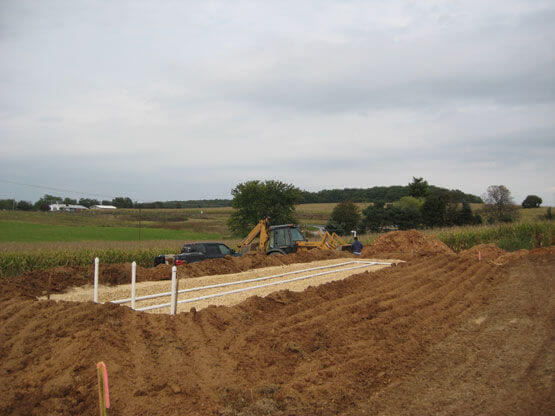The Pennsylvania Sewage Facilities Act (Act 537) was enacted on January 24, 1966, with the principle goal of dealing with both existent and future sewage disposal problems.
According to the act, all types of sewage disposal systems must be planned properly as per the guidelines set by the state and local governments on on-lot disposal systems (OLDS).
The act empowers the different municipalities to implement and enforce laws governing sand mounds and other types of septic systems.
As such, the respective municipalities have different codes that guide the permitting, planning, and operation of sand mound systems.
Let’s take a close look at the respective laws and guidelines that relate to sand mound systems in PA.
Sound Mound Regulations
The sound mound regulations in PA are defined in the 25 Pa. Code § 73.55.
The code outlines the design and maintenance requirements of the sound mound systems.
Design Requirements
I. Maximum slope
When installing a sand bed, the undisturbed soil gradient, measured to the extremities of the berm, should not be more than 12%.
The same standard (a maximum slope of 12%) also applies when installing sand mound trenches.
II. Limiting zone
A limiting zone refers to the elevation to be used as a yardstick for measuring the sand depth.
The limiting zone regulations require a minimum of 4 feet of satisfactory material between the top of the limiting zone and the bottom of the aggregate.
III. Minimum sand placement
A minimum of 1 foot of sand must be placed under the aggregate in all elevated sand mound systems.
IV. Utilizing mineral soils
The code expects any existing mineral soils to be utilized in the design and construction of the mound system.
As such, you are not allowed to remove or disturb any mineral soil and neither are you permitted to mix any fill material in the sand mound area.
Construction Requirements
I. Vegetation removal
When clearing the ground, there are stringent vegetation removal guidelines to follow.
Firstly, vegetation should be cut close to the ground and any trees or bushes should be cut flush with the ground surface.
The root system of the cut trees should remain untouched.
Finally, any cut vegetation should be cleared away from the area.
II. Slope and leveling of sand
The slope of the sand, not directly beneath the aggregate area, should be approximately 50%.
The top of the sand directly beneath the aggregate must be level to a tolerance of plus or minus two inches per 100 feet.
III. Plowing and sand placement
After clearing the vegetation, the proposed area for the sound mound should be plowed or roughed parallel with the contours.
The plowing should be to a maximum of six inches and only light-weight equipment should be used. Sand should then be immediately placed over the plowed area.
IV. Berm construction
When constructing the mound system, mineral soil should be used to make a berm which should then surround t elevated sand mound.
The berm should be made of less than 20% coarse fragments.
Additionally, these fragments should not be larger than 4 inches in diameter.
A minimum width of three feet at the top is recommended and it should also be slightly compacted for added stability.
V. Equipment Restrictions
No equipment, except lightweight equipment used for forming the downslope berm, should be permitted on the downslope side of the mound.
To the greatest extent possible, aggregate and cover material should be placed from the upslope side.
VI. Sand Requirements
The 25 Pa. Code § 73.55 requires the sand supplier to have written certification from the relevant permittee (in this case the sewage enforcement officer).
The purpose of this is to ensure that all sand supplied meets the requirements posted in the Department of Transportation specifications Publication #408, section 703.
For instance, the grading and side of the sand are meant to meet the bituminous concrete sand type B #1 or #3 requirements as prescribed by the Department of Transportation certified stockpile.
Impact of Multiple Absorption Areas
Even though it is technically possible to have several absorption areas on the property, you should exercise caution while at it.
This is because having multiple absorption areas on the same property can result in hydraulics overload of the soil.
As such, the law prohibits the placement of absorption areas hydraulically up gradient or down gradient from each other is generally prohibited unless proven otherwise through the alternative/experimental system process.
Elevated Sand Mound Beds
Apart from the guidelines above that guide sand mound design, the following additional requirements must also be adhered to for elevated sand mound beds.
- Bed Construction and gradient: The long axis of the absorption area should be perpendicular to the slope. In addition, you should construct the bed by following the natural contours. Also, the berm’s gradient should be less than 33.3%.
- Absorption Area Length-to-Width Ratio: The absorption area must have a minimum length-to-width ratio of 4 to 1.
Pennsylvania Uniform Construction Code (UCC)
In addition to the sound mound regulations, the UCC must also be taken into account.
This code is meant to guide the construction and alteration of any kind of building or structure.
It applies to sand mound systems since they are considered “structures.”
As per the UCC regulation, any sand mound installation must adhere to guidelines on the choice of materials, accessibility, setbacks, and other construction codes that may be imposed by the cities and municipalities.
